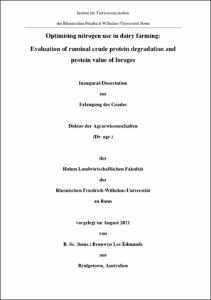Optimising nitrogen use in dairy farmingEvaluation of ruminal crude protein degradation and protein value of forages

Optimising nitrogen use in dairy farming
Evaluation of ruminal crude protein degradation and protein value of forages

| dc.contributor.advisor | Südekum, Karl-Heinz | |
| dc.contributor.author | Edmunds, Bronwyn Lee | |
| dc.date.accessioned | 2020-04-17T10:38:34Z | |
| dc.date.available | 2020-04-17T10:38:34Z | |
| dc.date.issued | 16.01.2012 | |
| dc.identifier.uri | https://hdl.handle.net/20.500.11811/5094 | |
| dc.description.abstract | A major goal of modern dairy farming is to decrease nitrogen inputs and increase efficiency of nitrogen utilisation by the dairy cow in order to minimise environmental pollution and save on expensive nitrogen supplements. Important steps in achieving this goal are to accurately assess and quantify ruminal degradation of feed protein as well as the amino acid supply and requirement of dairy cows. Quantifying these parameters, however, is challenging as current analytical methods are not sufficiently accurate and dietary crude protein (CP) is altered qualitatively and quantitatively by rumen microbes. The present study focussed on assessing the CP quality of fresh and conserved forages, in particular focussing on post rumen quality and quantity of undegraded feed CP and total CP passing to the intestines, where amino acid absorption occurs. The study has been divided into three sections. The first section describes an attempt to improve the accuracy of estimation of the proportion of feed CP escaping degradation in the rumen (RUP), using in situ and in vitro methods. The second section describes the recently developed modified Hohenheim gas test as a new, rapid and simple method of assessing the protein value (utilisable CP at the duodenum) of forages. The third section draws attention to how conservation methods could be employed to improve the protein value of forages: grass silage was pre-wilted to four levels of dry matter (DM: 20, 35, 50 and 65%) at two rates of moisture loss (fast, slow) and the effect on CP degradability, protein value and amino acid content was observed. Overall, the results of these studies were positive and progressive, whilst supporting results of other studies in showing that protein quality and supply from forages can be improved through methods used for conservation. Furthermore, the improvements to and standardisation of in vitro methods will aid in leading to higher levels of accuracy in estimating duodenal CP supply, thus reducing nitrogen emissions and optimising milk production, as well as presenting a range of other benefits such as reduced labour and financial expenditure and improved animal welfare through decreased requirement for experimental animals. | en |
| dc.language.iso | eng | |
| dc.rights | In Copyright | |
| dc.rights.uri | http://rightsstatements.org/vocab/InC/1.0/ | |
| dc.subject | Eiweiß | |
| dc.subject | Pansen | |
| dc.subject | Grünfutter | |
| dc.subject | Rohprotein | |
| dc.subject | Wiederkäuer | |
| dc.subject | Protein | |
| dc.subject | Rumen | |
| dc.subject | Forage | |
| dc.subject | Ruminants | |
| dc.subject.ddc | 630 Landwirtschaft, Veterinärmedizin | |
| dc.title | Optimising nitrogen use in dairy farming | |
| dc.title.alternative | Evaluation of ruminal crude protein degradation and protein value of forages | |
| dc.type | Dissertation oder Habilitation | |
| dc.publisher.name | Universitäts- und Landesbibliothek Bonn | |
| dc.publisher.location | Bonn | |
| dc.rights.accessRights | openAccess | |
| dc.identifier.urn | https://nbn-resolving.org/urn:nbn:de:hbz:5n-27594 | |
| ulbbn.pubtype | Erstveröffentlichung | |
| ulbbnediss.affiliation.name | Rheinische Friedrich-Wilhelms-Universität Bonn | |
| ulbbnediss.affiliation.location | Bonn | |
| ulbbnediss.thesis.level | Dissertation | |
| ulbbnediss.dissID | 2759 | |
| ulbbnediss.date.accepted | 22.12.2011 | |
| ulbbnediss.fakultaet | Landwirtschaftliche Fakultät | |
| dc.contributor.coReferee | Schellberg, Jürgen |
Dateien zu dieser Ressource
Das Dokument erscheint in:
-
E-Dissertationen (1035)




